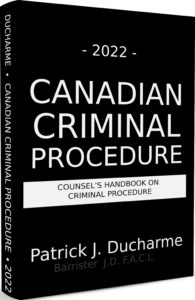 |
| Patrick J Ducharme |
In R. v. Godoy1 the Supreme Court of Canada considered the police powers to enter a residence forcibly to investigate an apparent emergency. In Godoy the police received a disconnected 911 call. Police were able to determine the location by the call. The police arrived at the apartment and knocked on the door. A male answered the door and told the police that there was “no problem” and invited them to leave. When the officers asked if they could enter the apartment to investigate, the male tried to close the door. The officers forced their way into the apartment. Once inside, they heard a woman crying.
The woman was Godoy’s common-law wife. She had been injured by the accused. The court found that although forcible entry by the police into a private dwelling house generally constitutes interference with a person’s liberty and property, entry was justified in the circumstances of a distress call. The court found that there was no other reasonable alternative to ensure that the disconnected caller received the necessary assistance in a timely manner.
Police officers are now permitted to exercise more extended powers of entering a dwelling house based on reasonable grounds of emergency. The case of Godoy is an example of the court acknowledging these extended powers. This duty is engaged whenever it can be inferred that the 911-caller is or may be in imminent danger. in the absence of an emergency, however, entry by the police into a private dwelling without an arrest warrant often proves problematic. So problematic that valuable evidence discovered and seized may be ruled inadmissible without a proper legal foundation for the entry.

The above is the an excerpt of Patrick J Ducharme's book, Canadian Criminal Procedure, available at Amazon or in bulk through MedicaLegal Publishing along with Criminal Trial Strategies.
Subscribe to Patrick Ducharme's Youtube Channel
